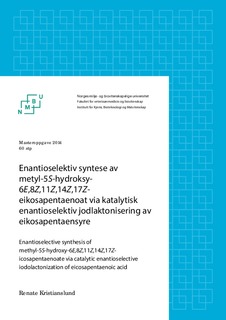| dc.description.abstract | Hovedfokuset i denne oppgaven var å utvikle en metode for organokatalytisk enantioselektiv jodlaktonisering av (5Z,8Z,11Z,14Z,17Z)-eikosa-5,8,11,14,17-pentaensyre (EPA, 20) med forskjellige kvadratsyre-katalysatorer; 3-(((1R,2R)-2-(dipentylamino)sykloheksyl)amino)-4-((4-(trifluorometyl)fenyl)amino)syklobut-3-en-1,2-dion (56), 3-((3,5-
bis(trifluorometyl)fenyl)amino)-4-(((1R,2R)-2-(dipentylamino)sykloheksyl)amino)syklobut-
3-en-1,2-dion (57), 3-(((1R,2R)-2-(dipentylamino)sykloheksyl)amino)-4-((4-
(trifluorometyl)benzyl)amino)syklobut-3-en-1,2-dion (58), 3-((3,5-
bis(trifluorometyl)benzyl)amino)-4-(((1R,2R)-2-(dipentylamino)sykloheksyl)amino)syklobut-
3-en-1,2-dion (59), 3-(((1R,2R)-2-(dipentylamino)sykloheksyl)amino)-4-(pyridin-2-
ylamino)syklobut-3-en-1,2-dion (60), 3-(((1R,2R)-2-(dipentylamino)sykloheksyl)amino)-4-
(pyridin-3-ylamino)syklobut-3-en-1,2-dion (61), 3-(((1R,2R)-2-
(dipentylamino)sykloheksyl)amino)-4-(pyridin-4-ylamino)syklobut-3-en-1,2-dion (62) og 3-
(((1R,2R)-2-(dipentylamino)sykloheksyl)amino)-4-(isoquinolin-1-ylamino)syklobut-3-en-1,2-dion (63). Flere forskjellige metoder og varierende reaksjonsbetingelser ble forsøkt, men alle forsøkene som ble gjennomført med organokatalysatorer ga rasemiske jodlaktoner (15).
Det ble utviklet en metode for katalytisk enantioselektiv jodlaktonisering av EPA (20) som ga tetrahydro-6-((3Z,6Z,9Z,12Z)-1-jodpentadekatetraenyl)pyran-2-on (15) i 24 % enantiomert overskudd ved bruk av (R,R)-(-)-N,N′-bis(3,5-di-tert-butylsalicyliden)-1,2-
sykloheksandiaminokobolt(II) (64) som katalysator. Ved å utføre syntese av
(6E,8Z,11Z,14Z,17Z)-metyl-5-hydroksy-6,8,11,14,17-eikosapentaenoat (18) fra jodlaktonet
15 med enantiomert overskudd, ble det vist at S-enantiomeren av forbindelse 18 hadde blitt dannet i overskudd og stereokjemien ble bevart i reaksjonene fra jodlaktonet 15 til
hydroksymetylesteren 18. Tilordningen av S- og R-enantiomer toppene i kromatogrammet av 18 ble utført ved å esterifisere en kommersielt tilgjengelig prøve av (6E,8Z,11Z,14Z,17Z)-5Shydroksy-6,8,11,14,17-eikosapentaensyre (5-(S)-HEPE, 9) til (6E,8Z,11Z,14Z,17Z)-metyl-5Shydroksy-6,8,11,14,17-eikosapentaenoat (65) og analysere den med HPLC med en kiral kolonne. Det ble ikke tid til forsøk på å videreutvikle metoden for enantioselektiv jodlaktonisering av EPA (20) med katalysator 64.
Katalytisk enantioselektiv jodlaktonisering av 20 muliggjør enantioselektiv syntese av den
biologisk aktive EPA-metabolitten 5-(S)-HEPE (9) i større mengder for å kunne utføre
biologiske studier. Dessuten kan det muliggjøre katalytisk enantioselektiv jodlaktonisering av også andre liknende substrater som for eksempel (4Z,7Z,10Z,13Z,16Z,19Z)-dokosa-
4,7,10,13,16,19-heksaensyre (DHA) og (5Z,8Z,11Z,14Z)-eikosa-5,8,11,14-tetraensyre (AA). Katalytisk enantioselektiv jodlaktonisering av EPA og muligens andre liknende substrater gir et jodlakton med enantiomert overskudd som kan modifiseres videre til også mange andre forbindelser.
Det ble utviklet en metode for HPLC-analyse med en kiral kolonne som ga grunnlinjeseparasjon av enantiomerene av 15 og 18.
Synteser av 3-(((1R,2R)-2-(dipentylamino)sykloheksyl)amino)-4-
((4(trifluorometyl)benzyl)amino)syklobut-3-en-1,2-dition (76), 60, 61, 62 og 63 ble
gjennomført. Dette er to nye klasser av potensielle organokatalysatorer som bør testes videre i allerede utviklede enantioselektive reaksjoner for å evaluere deres effekt.
The main focus of this thesis was to develop a method for organocatalytic enantioselective
iodolactonization of (5Z,8Z,11Z,14Z,17Z)-icosa-5,8,11,14,17-pentaenoic acid (EPA, 20) by
using a selection of known and novel squaramide-catalysts; 3-(((1R,2R)-2-
(dipentylamino)cyclohexyl)amino)-4-((4-(trifluoromethyl)phenyl)amino)cyclobut-3-ene-1,2-
dione (56), 3-((3,5-bis(trifluoromethyl)phenyl)amino)-4-(((1R,2R)-2-
(dipentylamino)cyclohexyl)amino)cyclobut-3-ene-1,2-dione (57), 3-(((1R,2R)-2-
(dipentylamino)cyclohexyl)amino)-4-((4-(trifluoromethyl)benzyl)amino)cyclobut-3-ene-1,2-
dione (58), 3-((3,5-bis(trifluoromethyl)benzyl)amino)-4-(((1R,2R)-2-
(dipentylamino)cyclohexyl)amino)cyclobut-3-ene-1,2-dione (59), 3-(((1R,2R)-2-
(dipentylamino)cyclohexyl)amino)-4-(pyridine-2-ylamino)cyclobut-3-ene-1,2-dione (60), 3-
(((1R,2R)-2-(dipentylamino)cyclohexyl)amino)-4-(pyridine-3-ylamino)cyclobut-3-ene-1,2-
dione (61), 3-(((1R,2R)-2-(dipentylamino)cyclohexyl)amino)-4-(pyridine-4-
ylamino)cyclobut-3-ene-1,2-dione (62) and 3-(((1R,2R)-2-(dipentylamino)cyclohexyl)amino)-4-(isoquinolin-1-ylamino)cyclobut-3-ene-1,2-dione (63). Different methods for
iodolactionization of 20 and various reaction conditions have been explored. Unfortunately, all attempts with organocatalysts provided racemic iodolactones 15.
A method for catalytic enantioselective iodolactonization of EPA (20) utilizing (R,R)-(-)-
N,N′-bis(3,5-di-tert-butylsalicylidene)-1,2-cyclohexanediaminocobalt(II) (64) as a catalyst
was developed. The resulting tetrahydro-6-((3Z,6Z,9Z,12Z)-1-iodopentadecatetraenyl)pyran-2-one (15) was obtained in 24 % enantiomeric excess. Further synthesis from the iodolactone 15 with enantiomeric excess to the corresponding hydroxymethylester (6E,8Z,11Z,14Z,17Z)-methyl-5-hydroxy-6,8,11,14,17-icosapentaenoate (18) gave the S-enantiomer in excess with full retention of stereochemistry. Assignment of the S- and R-enantiomer of 18 in the chromatogram was accomplished by esterification of a sample of commercially available (6E,8Z,11Z,14Z,17Z)-5S-hydroxy-6,8,11,14,17-icosapentaenoic acid (5-(S)-HEPE, 9) to the corresponding methyl ester (6E,8Z,11Z,14Z,17Z)-methyl-5S-hydroxy-6,8,11,14,17-icosapentaenoate (65) which was analyzed by HPLC with a chiral column. Unfortunately, there was no more time for attempts to further develop the method for catalytic enantioselective iodolactonization of EPA (20) in the presence of catalyst 64.
Catalytic enantioselective iodolactonization of 20 provides a route to enantioselective
synthesis of 5-(S)-HEPE (9). This oxygenated PUFA is a biologically active metabolite from EPA and larger amounts of the compound is needed for biological studies. In addition, catalytic enantioselective iodolactonization of EPA and possibly other similar substrates (e.g. (4Z,7Z,10Z,13Z,16Z,19Z)-docosa-4,7,10,13,16,19-hexaenoic acid (DHA) and (5Z,8Z,11Z,14Z)-icosa-5,8,11,14-tetraenoic acid (AA)) can be used as a key step in the synthesis of many other compounds.
An HPLC-method with a chiral column giving baseline separation of the enantiomers of 15
and 18 was developed.
Synthesis of 3-(((1R,2R)-2-(dipentylamino)cyclohexyl)amino)-4-
((4(trifluoromethyl)benzyl)amino)cyclobut-3-ene-1,2-dithione (76), 60, 61, 62 and 63 was
accomplished. These two novel classes of potential organocatalysts should be further tested in previously developed and known enantioselective reactions in order to evaluate their effect. | nb_NO |
